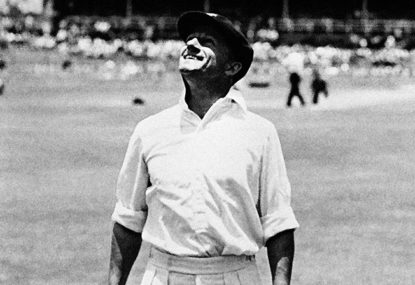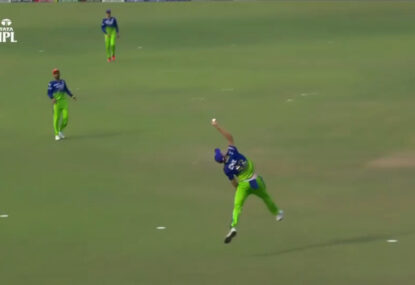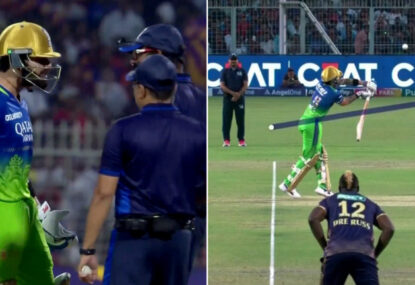In the final Test of an ill-fated Ashes campaign at the Oval, Michael Clarke captains Australia for the last time after announcing his retirement from Test cricket last week.
Clarke’s final series as captain has been a forgettable one – for both himself and the team. However it was a far different scenario 67 years ago when another Australian captain also played his last Test at the same venue.
On the morning of the first day of the fifth Test of the 1948 Ashes series, England captain Norman Yardley won the toss of the coin, and elected to bat first on a rain-affected pitch.
The English went into the final Test at The Oval trailing Australia 0-3 in the series, and had made a number of changes to their side. One of which was Eric Hollies.
Hollies was a prolific wicket taker at first class level but had struggled to replicate that success in Test cricket, and had played only a sporadic handful of Tests since his debut against the West Indies some 13 years previously.
The Australian’s dominance throughout the series continued on the first morning, with Australia’s bowlers led by Ray Lindwall, dismissing England for a meagre 52 runs.
Conversely, the Australian opening pair of Arthur Morris and Sid Barnes looked at ease. They doubled England’s score before Barnes was caught behind off Hollies late in the afternoon for 61.
His dismissal brought Australian captain Don Bradman to the crease, in what could possibly be his final Test innings if, as now expected after England’s lowly first innings score Australia were only required to bat once. As such, he was greeted with a generous standing ovation from the English crowd as he made his way to the middle of the ground.
Such was Bradman’s standing in the game, Yardley gathered his players in as Bradman strode to the wicket. The English team to a man gave him three cheers. The predominately English crowd enthusiastically joining them, echoing their team’s respect.
Bradman marked his stance as Eric Hollies prepared to bowl his leg breaks from around the wicket. The first delivery was on the stumps, and Bradman looking slightly rushed, steps back and defends.
The second strays a little down the leg side, but then pitches and spins sharply towards Bradman’s off stump. The Don plays a forward defensive shot, but misjudges it, and is bowled off an inside edge.
The silence from the crowd is deafening. No-one can believe what they have just witnessed. Donald Bradman, the greatest batsman the world has seen, coming off an unbeaten 173 in his last innings, averaging 83 in the series and needing only four runs to average 100 in Test cricket, had been bowled in his final innings for a second ball duck.
The legend of 99.94 had begun.
It is a number that any Australian cricket follower knows intimately. The Don’s batting average of 99.94.
Even many Australians who do not follow cricket know it. It is a number that is etched into our cultural fabric. Some would even suggest that you are not truly Australian unless you know it, and what it represents.
Although the mystique of the Don’s batting average will continue well into the future. Nearly 70 years and three generations after he played his last Test match for Australia, the legend has begun to obscure the reality. It has become easier to just know he was the best, without actually knowing why.
Sir Donald Bradman is generally regarded to be the greatest cricketer that ever lived, and that most likely ever will. There is of course no doubt that many may disagree, particularly in India, where the sub continent’s little master, Sachin Tendulkar, is held in almost godlike reverence.
However anyone disputing that Bradman is the greatest is doing so purely on emotion rather than fact. Not only does the evidence prove the Don was the greatest cricketer that ever lived, it also shows he is arguably the greatest ever sportsman.
Bradman’s batting average of 99.94, is 39 runs per innings better than any other batsman that has played more than 20 Test matches. The next best being Graeme Pollock (South Africa), George Headley (West Indies), and Herb Sutcliff (England), who all averaged 60.
To put that figure into perspective, any batsman who averages 40 and above in Test cricket is considered a good Test batsman.
Former Australian captains Mark Taylor and Ian Chappell averaged 43.49 and 42.42 respectively, and are considered two of Australia’s finest. Bradman’s average is almost Taylor or Chappell’s average higher than Pollock’s. Or alternatively, an astounding 75 per cent.
When Bradman retired he had scored a total of 6996 runs in 52 Test matches, the most by any batsman. He scored 29 centuries, 12 double centuries and two triple centuries – one of those scored in a single day. Indeed on six occasions he scored a century in a single session, a feat almost unheard of today.
Although having an average below that of Pollock, Headley and Sutcliff, many experts consider Sachin Tendulkar to be the best Test batsman since Bradman. Tendulkar has scored a world record 15,921 runs at an average of 53.79, with 51 centuries, six double centuries and a high score of 248 not out.
Had Bradman played 200 Test matches and his average remained the same or close to it, he would have scored over 25,000 runs, had over a hundred centuries, and over 40 double centuries. That is not taking anything away from Tendulkar, whose Test record is astounding, it’s just that Bradman was that good.
So good in fact, that the infamous Bodyline series of 1932 in which English captain Douglas Jardine devised, and implemented his infamous ‘fast leg theory’ tactic, was solely to curb Bradman’s influence.
It did work, as Bradman only averaged 49.5 in four Tests, with one century, and England won the series 4-1. However the damage the tactic did to the game, as well as the relationship between the two countries was profound, and Jardine never captained the English side again.
Of course it could be argued that Bradman played virtually no-one but England, while others, such as Tendulkar played a far greater range of Test opponents, in many more countries, and in a wider variety of conditions.
However although Bradman did play mostly against England, he did play five Tests each against India, at an average of 178.75, South Africa at 201.50, and the West Indies at 74.50.
He also played with inferior equipment, and one could only imagine how much he would have scored on the dry, flat, bat friendly pitches of the sub-continent, instead of the uncovered seaming pitches Test cricketers plied their trade on at the time.
Who knows what his average might have been.
Don Bradman records
Highest career batting average (minimum 20 innings): 99.94
Highest series batting average (4 or more Test series): 201.50 (1931–32) and second highest 178.75 (1947–48)
Highest ratio of centuries per innings played: 36.25% (29 centuries from 80 innings)
Highest ratio of double centuries per innings played: 15.0% (next highest is 5%)
Highest fifth wicket partnership: 405 (with Sid Barnes, 1946–47)
Second highest sixth wicket partnership: 346 (with Jack Fingleton, 1936–37)
Second highest score by a number 5 batsman: 304 (1934)
Highest score by a number 7 batsman: 270 (1936–37)
Most runs against one opponent: 5,028 (v England)
Most runs in one series: 974 (1930)
Most centuries scored in a single session of play: 6 (1 pre-lunch, 2 lunch-tea, 3 tea-stumps)
Most runs in one day’s play: 309 (1930)
Most double centuries: 12
Most double centuries in a series: 3 (1930)
Most triple centuries: 2 (equal with Chris Gayle, Brian Lara and Virender Sehwag)
Most consecutive matches in which he made a century: 6 (the last three Tests in 1936–37, and the first three Tests in 1938)
Fastest Australian to reach 1000 Test runs (13 innings)
Fewest matches required to reach 1000 (7 matches), 2000 (15 matches), 3000 (23 matches), 4000 (31 matches), 5000 (36 matches) and 6000 (45 matches) Test runs.
Fewest innings required to reach 2000 (22 innings), 3000 (33 innings), 4000 (48 innings), 5000 (56 innings) and 6000 (68 innings) Test runs.
Bradman averaged over 100 in seven different calendar years (*qualification 400 runs). No other player has achieved this in more than two calendar years




































































































